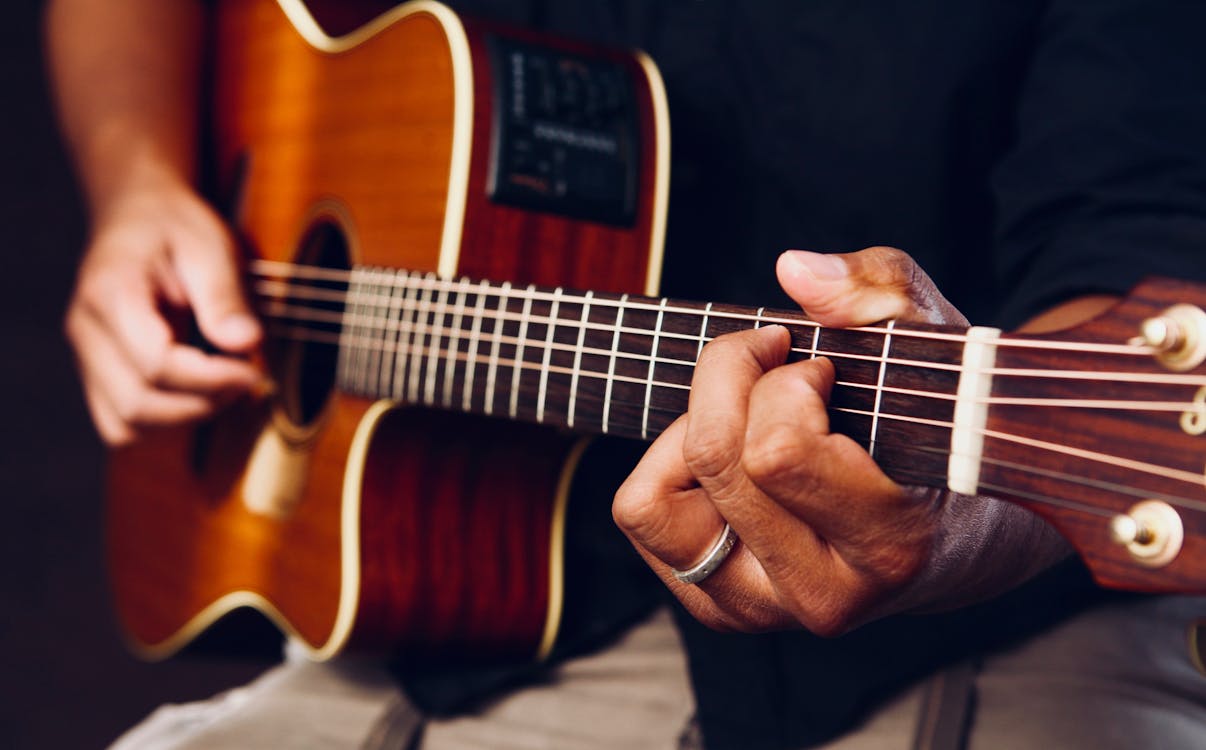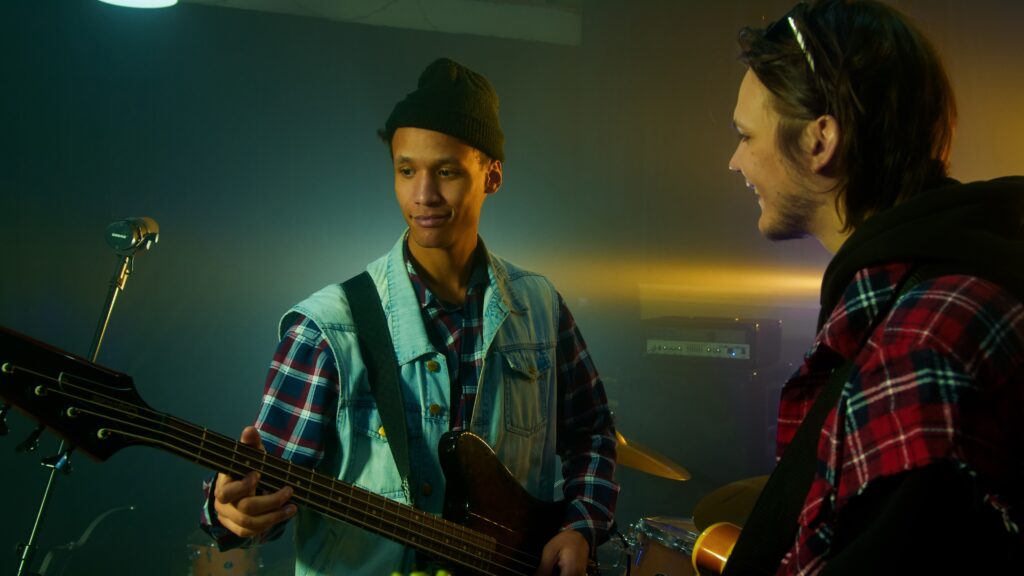Are you a lefty thinking of playing your dad’s old guitar you found in the attic, but it’s right-handed and you’re not? The thought must have crossed your mind to just change the orientation of the guitar, but can you make a right-handed guitar left-handed, and is it worth it?
Those are the exact questions we are going to aim to answer in today’s article. Let’s begin!
What’s the difference between a right-handed guitar and a left-handed one?
So, how do you spot a left-handed guitar? What is the difference between a right-handed one and a left-handed one? Well, the difference is primarily in the order of the strings! Hold the guitar with its body facing you and look at the strings. Are the strings getting thicker from left to right or are they getting thinner? If the thickest string is on the left and the thinnest one is on the right, then you’ve got yourself a right-handed guitar. However, if the guitar has strings increasing in thickness from left to right, then it’s a left-handed one!
Another sign that your guitar is left-handed, can be its shape! Depending on hand orientation, the shape of guitars differs. The dips and curves are usually matched to either left or right-handed playing styles!
Can You Make A Right-Handed Guitar Left-Handed?
Well, the answer to this question depends on your guitar. In some guitars, such as classical ones, the process of changing the guitar from right-handed to left-handed can be as simple as changing the order of the strings.
However, more complex acoustic and electric models might also require changes in other components of the guitar too!
For instance, the nuts in both acoustic and electric guitars are designed to fit thicker to thinner strings from left to right. If you restring your guitar to make it lefty-friendly, the strings won’t be able to fit in the grooves on the nut. The thicker strings just won’t go in and the thinner ones will move around and create an annoying rattle while playing. The same issue stands for saddles in acoustic guitars. A couple of solutions to this problem would be to either flip the nut or saddle or to get a new one designed for a lefty. We recommend getting new ones and letting a professional handle these changes.
A reversed bridge would create problems with intonation, which can be a real issue in Gibson guitars.
You will also have to remove and change the position of the strap peg on your guitar to make it usable when playing left-handed.
Some electric guitar-specific issues would be that all the knobs and switches for adjustment on the guitar would be upside down and thus hard to reach. The tremolo bar will also be flipped upside down.
Another issue with changing your guitar from right-handed to left-handed is the possibility of you damaging your guitar in the conversion process.
Despite making all the necessary conversions, your guitar’s shape can make it uncomfortable to play as some guitar bodies are tailor-made to suit right-handed playing.
| Question | Answer |
|---|---|
| Can you physically play a right-handed guitar left-handed? | Yes, it’s possible to physically play a right-handed guitar left-handed. |
| Can you restring a right-handed guitar for left-handed playing? | Yes, it’s possible to restring a right-handed guitar for left-handed playing. |
| What are the challenges of playing a right-handed guitar left-handed? | The biggest challenge is typically adapting to the reversed string order. Other challenges include the guitar’s design and the player’s comfort. |
| Can you flip a right-handed guitar over and play it left-handed? | It’s technically possible, but not recommended due to the guitar’s design and the positioning of the controls. |
| Are there left-handed guitars available on the market? | Yes, there are left-handed guitars available on the market specifically designed for left-handed players. |
| Should a left-handed player learn to play on a right-handed guitar? | It’s a personal preference, but many left-handed players do learn to play on right-handed guitars due to the limited availability of left-handed models. |
Do left-handed people have any effect on guitar playing?
Left-handed people have a natural advantage when it comes to playing guitar. This is because left-handed individuals can more easily access chords and notes on the fretboard. In addition, they can quickly switch strings without having to adjust their hand position. This allows them to play faster and with greater accuracy than their right-handed counterparts.
The reason for this is that the body mechanics of a left-hander are different from those of a right-hander. Right-handers naturally use their dominant hand for fretting, while lefties use their non-dominant hand.
The difference in hand position means that lefties don’t have to adjust as much when switching between chords and notes, allowing them to play more quickly and accurately.
Lefties also have an advantage when it comes to learning new techniques and styles faster. Because they can access the strings differently, they may be able to understand different techniques more quickly than right-handers who must adjust their hand positions according to the technique being used.
How to turn a right-handed guitar into a left-handed guitar?
Converting a right-handed guitar into a left-handed one is not as difficult as it may seem. It is a simple process that mostly consists of adjusting the strings, tuning pegs, and bridging.
First, you will need to reverse the strings on the guitar. If the guitar is an acoustic guitar, you will need to take off the strings and flip them around so that they are running in opposite directions. Then reattach them to the headstock of the guitar in their new positions. If it is an electric guitar, simply switching around the output jack should do it.
Next, you’ll have to adjust the tuning pegs so that they are facing away from your body when playing rather than towards it like on a right-handed setup. This can be done by loosening all of the strings and then turning each peg 180 degrees clockwise.
Finally, you’ll need to switch out or adjust your bridge for left-handed use. If it’s an acoustic guitar, this means making sure that all of the saddles are adjusted correctly for string height and intonation in their new positions.
For electric guitars, you may need to switch out the bridge entirely if yours is not designed for both left-handed and right-handed players.
Once these small adjustments have been made, your left-handed guitar should be ready to play!
Can a left-handed person play a right-handed guitar upside down?
Yes, a left-handed person can play a right-handed guitar upside down. This technique is sometimes called “reverse-strung guitar playing“.
It involves the left-handed guitarist reversing the strings on their right-handed guitar so that they can play it in the opposite direction. The easiest way to do this is to simply unscrew and reverse the tuning pegs so that they are pointing away from you instead of towards you when playing.
The main advantage of this technique is that it allows left-handers to access the fretboard and strings more easily, as the strings are closer to their dominant hand.
Furthermore, due to their reversed hand positioning, they can move around from string to string much more quickly than a traditional right-hander would be able to.
However, one disadvantage of playing a right-handed guitar upside down is that lefties may struggle with finger placement on certain frets due to the reversed orientation.
Additionally, due to the reversed string positions, some chords will sound different and may take some time for a lefty to get used to.
What guitarist plays a right-handed guitar left-handed?
One of the most notable guitarists to play a right-handed guitar left-handed is Jimi Hendrix. Although he was naturally left-handed, he learned to play a right-handed guitar upside down to access the strings more easily and quickly.
Other prominent lefties who have played a right-handed guitar include Kurt Cobain, Paul McCartney, Eddie Van Halen, and Tony Iommi. All of these musicians used their techniques to make playing a right-handed guitar easier and more comfortable for them while still keeping the same sound.
Lefties who want to learn how to play a right-handed guitar should take their time learning and experimenting with different techniques to find what works best for them. It may take some practice, but it can be done!
How do left-handed people learn guitar?
Left-handed people can learn guitar in the same way as right-handed players, although there are some key differences that lefties must take into account.
The most important is to reverse the strings on the instrument, which involves unscrewing and reversing the tuning pegs so that they are pointing away from you instead of towards you when playing. This allows them to access the strings more easily, as they’re closer to their dominant hand.
Left-handers should also adjust their hand positioning when playing chords and scales so that they can play with greater accuracy and speed. This means adjusting their wrist angle so that they can comfortably reach notes on the fretboard while still keeping their fingers close enough together to make chord shapes.
Left-handers may also need to adjust the bridge of an electric guitar for it to be usable for a lefty if it isn’t designed for both right-handed and left-handed players. They will also need to be aware of any issues with intonation and string height when adjusting this part of the guitar.
Learning how to read guitar tabs and sheet music is another important part of learning guitar for all players, regardless of their handedness.
However, lefties may struggle more with reading notation due to its orientation being reversed from what they’re used to seeing with other writing instruments like pencils or pens.
Finally, left-handed people should practice regularly to develop their skills and become comfortable playing the instrument in a way that feels natural for them.
How long does it take to learn the guitar?
Learning to play the guitar can be a daunting task, but it is also one of the most rewarding skills you can acquire.
It takes dedication and practice to become proficient at playing the instrument, so how long does it take? The answer depends on many factors such as your skill level, commitment level, and even your natural aptitude for music.
Conclusion
To conclude, the answer to the question: can you make a right-handed guitar left-handed, is yes. But the answer to whether should you make a right-handed guitar left-handed is a no (in most cases). The good news is that left-handed guitars don’t cost that much more when compared to right-handed ones. So go out and get a guitar that fits you perfectly!





